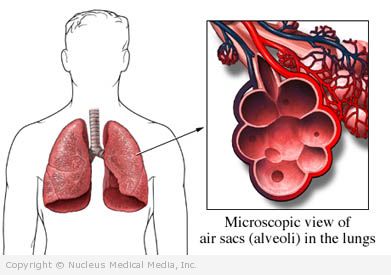Allergic bronchopulmonary aspergillosis – ABPA
Allergic bronchopulmonary aspergillosis – Definition
Allergic bronchopulmonary aspergillosis (ABPA) is an allergic lung disorder. It is related to the fungus Aspergillus fumigatus (AF). Aspergillosis can also occur as:
- A lung infection that can spread to other parts of the body (more common in patients with suppressed immune systems)
- A fungal growth ( aspergilloma) in a lung cavity that has healed from a previous lung disease or infection
Allergic bronchopulmonary aspergillosis – Causes
ABPA is caused by an allergic reaction to inhaled AF. AF is a common fungus. It grows and flourishes in decaying vegetation, soil, certain foods, dust, and water. The allergic reaction worsens respiratory symptoms in people with asthma or cystic fibrosis. The inhaled AF colonizes mucus in the lungs, causing:
- Sensitization to AF
- Recurring allergic inflammation of the lungs
- Packing of the alveoli (tiny air sacs in the lungs) with eosinophils (a type of white blood cell involved in certain allergic reactions and infections with parasites)
Allergic bronchopulmonary aspergillosis – Risk Factors
A risk factor is something that increases your chances of getting a disease or condition. Risk factors for ABPA include:
- Asthma
- Cystic fibrosis
- Tuberculosis
- Sarcoidosis
Allergic bronchopulmonary aspergillosis – Symptoms
Symptoms of ABPA are usually those of progressive asthma. These include:
- Shortness of breath
- Wheezing
- Weakness, malaise
- Unintended weight loss
- Chest pain
As ABPA progresses, other symptoms may occur, including:
- Production of thick, brownish, and/or bloody sputum
- Low-grade fever
In severe, long-term cases, ABPA can cause:
- Bronchiectasis — widening of areas of the bronchus, usually caused by inflammation
- Scarring of lungs
Allergic bronchopulmonary aspergillosis – Diagnosis
The doctor will ask about your symptoms and medical history, and perform a physical exam. Tests may include:
- Chest x-ray — a test that uses radiation to take a picture of structures inside the body, in this case the lungs
- Sputum tests — to check sputum for:
- Presence of AF
- High levels of eosinophils
- Blood tests to detect:
- High levels of eosinophils
- Antibodies suggesting an allergic reaction to AF
- Skin prick tests — to check for allergic sensitivity by placing small amounts of AF in the skin
- Biopsy of lung or sinus tissue
- Pulmonary function tests (PFTs) — used to monitor breathing capacity of the lungs
Since ABPA can appear quite similar to non-ABPA induced asthma, it is often difficult to determine to what extent ABPA is contributing to your symptoms. Therefore, ABPA is typically diagnosed after several repeat tests for ABPA are positive over a number of months or years.
Allergic bronchopulmonary aspergillosis – Treatment
The goals of treatment include:
- Suppressing the allergic reaction to AF
- Minimizing lung inflammation
- Preventing AF from colonizing the lungs
ABPA is usually treated with:
- Prednisone (an oral corticosteroid medication)
- Antifungal drugs
Allergic bronchopulmonary aspergillosis – Prevention
Avoiding exposure to AF is the best way to prevent ABPA. However, this is difficult, because AF is so prevalent in the environment. Guidelines to help prevent exposure to AF include:
- Avoiding areas with:
- Decaying vegetation
- Standing water
- Keeping your home as dust-free as possible
- Remaining in air-filtered, air-conditioned environments whenever possible
Measures to avoid symptoms and prevent permanent lung damage caused by ABPA include:
- Ongoing testing and monitoring of ABPA
- Early and continuing medical treatment for the disease

